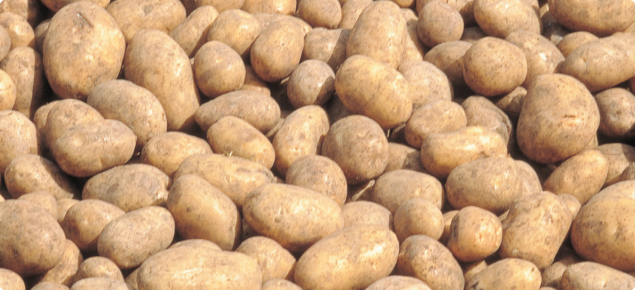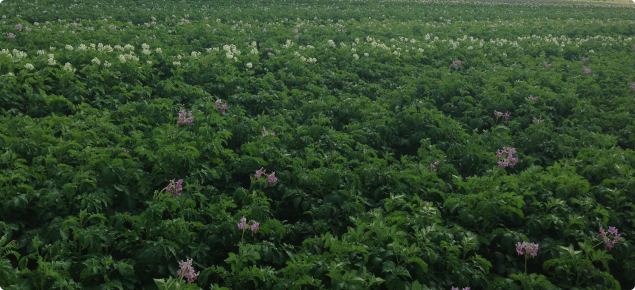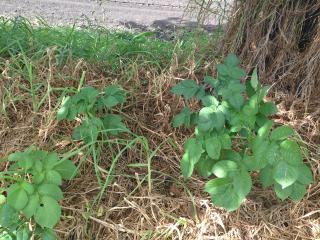Strains and symptoms
A number of different strains of PVY can occur. In Western Australia, the ‘ordinary’ or ‘o’ strain has been detected in potatoes, however in Victoria and South Australia the ‘NTN’ strain is present. Other strains occur overseas.
Symptoms of infection vary with cultivar, plant age, environmental conditions and PVY strain. Leaf symptoms can range from mild to severe mosaic or mottling. In severe cases leaf drop can occur. Infected plants are often stunted.
Tubers from infected plants are often small and can have necrotic or dead rings on the skin.
Sources of virus
Infected seed potato tubers are the principal source of PVY spread to other potato plants. Sources are old potato crops, volunteer or self-sown potatoes, crops including capsicum, tomato and tobacco, and weeds such as nightshade and cape gooseberry.
Infected old crop plants, self-sown potato plants and weeds allow the virus to survive between growing seasons. These plants are often found growing within crops, on roadside verges and along fencelines.
PVY is spread from these infected plants to potato crops by aphids. PVY has a wide host range including plants in the Solanaceae, Amaranthaceae and Chenopodiaceae families.
Aphid vectors and transmission
PVY is primarily spread by aphids, including green peach (Myzus persicae) and potato (Macrosiphum euphorbiae) aphids, as well as other species that migrate through the crop.
PVY is transmitted non-persistently. This means when an aphid feeds on a PVY-infected plant, it picks up the virus within 1-2 seconds of feeding. If the aphid then moves to a healthy plant and begins to feed (for 1-2 seconds) the virus is released and transferred to the healthy plant leading to infection. After the aphid has probed one or two healthy plants the virus is lost until it probes another infected plant.
A small number of aphids can spread the virus to a large number of plants quickly as they search for a suitable host plant to colonise.
Contact transmission
PVY is readily spread between plants when machinery damages infected leaves and the infective sap then brushes or rubs onto healthy plants. Such virus spread can be reduced by cleaning cutting implements and machinery with a 1:4 dilution of household bleach followed by water rinse; 1% Virkon; or a 20% solution of skim milk powder.
Yield and quality losses
When potato plants become infected early, yield losses of 10-80% have been reported. Losses can be due to small and few tubers being produced. The severity of symptoms and magnitude of yield depends on the time of infection, number of plants infected, strain of the virus and the variety grown.
Management
To minimise PVY spread in potato crops an integrated disease management approach is necessary, however the most important management practice is to use seed lots with zero levels of PVY. The addition of other practices in combination will provide added control.
- Plant seed potatoes with zero level of PVY. WA certified and registered seed potatoes with Rating 1 and Rating 2 have a zero tolerance for PVY.
- Use PVY resistant potato varieties when available. Commercial varieties used in WA that are resistant to PVY are Royal Blue, FL1867 and FL2195.
- Plant a non-host border crop around the potato crop about four weeks before planting, for example, wheat, oats, sorghum. This acts as a cleansing barrier for aphids. If PVY is entering the crop from an outside source then infective aphids may feed on the barrier crop, lose the virus and will no longer be infective when they land on the potato crop.
- Plant new crops upwind from older crops – there is less infection upwind from infection sources as aphids can be blown along with the wind.
- Remove any potato plants showing virus symptoms – removing virus sources within the crop may help to slow down the spread of the virus to nearby plants especially early in the season.
- Employ good hygiene practices. Use 1:4 dilution of household bleach or 1% Virkon to wash equipment and machinery.
- Avoid moving machinery, equipment and workers from old crops to new ones to minimise spread from older to young crops.
- Remove and destroy old potato crops immediately after the final harvest to minimise virus spread to new crops.
- Destroy volunteer potato plants and weeds before planting to reduce any potential virus and aphid sources for new crops.
Insecticides are ineffective
It is important to note that although PVY is spread mainly by aphids, insecticides are ineffective as a control measure because they do not work fast enough to prevent aphids from feeding on and infecting a healthy plant before it is killed.
Mineral oils have been used overseas to limit PVY spread. These oils interfere with aphid feeding and virus transmission. It is important to note phytotoxic damage has been reported from their use.
Acknowledgement
This work was supported with funding from the Potato Producers' Committee of the Agricultural Produce Commission with in-kind support from the Department of Primary Industries and Regional Development.



